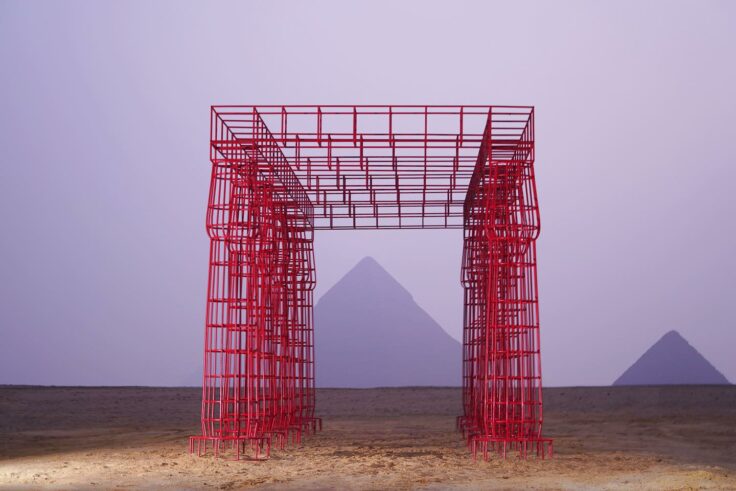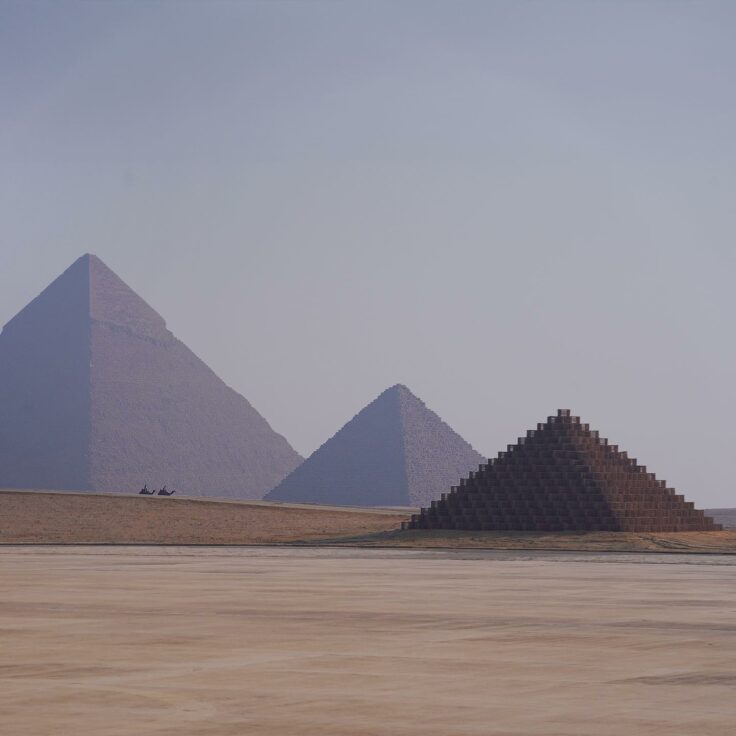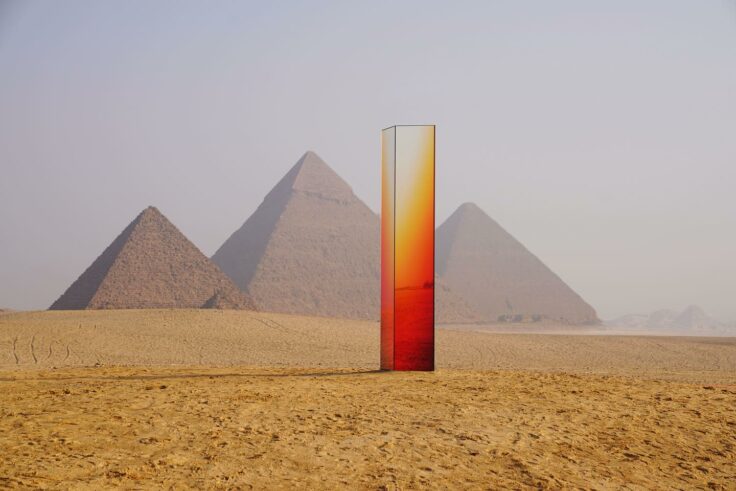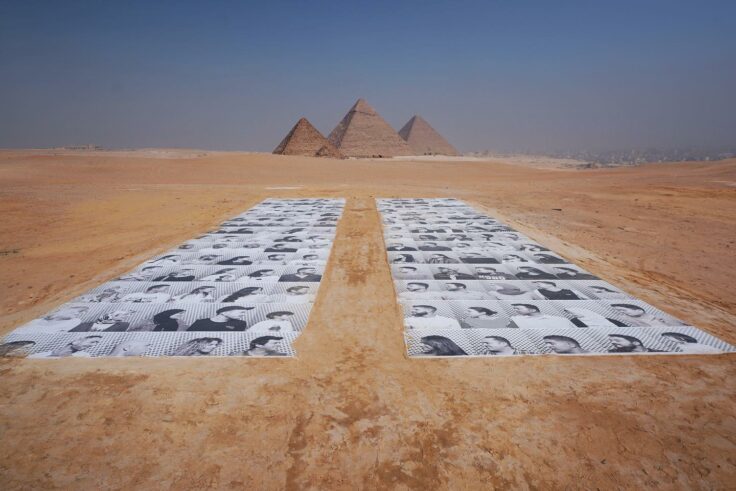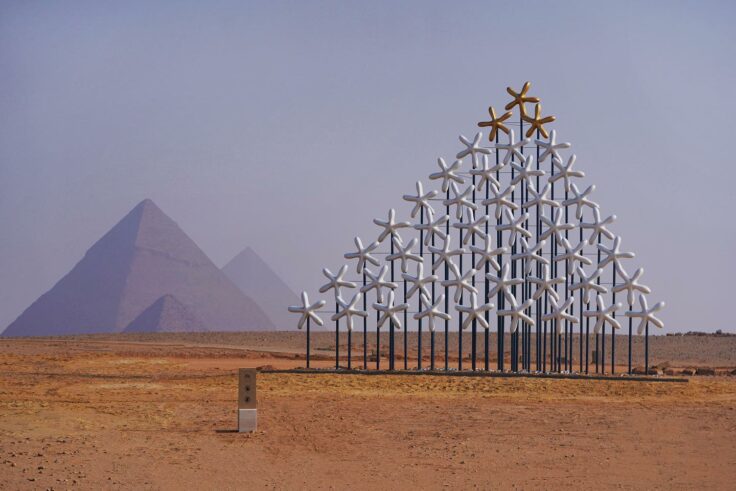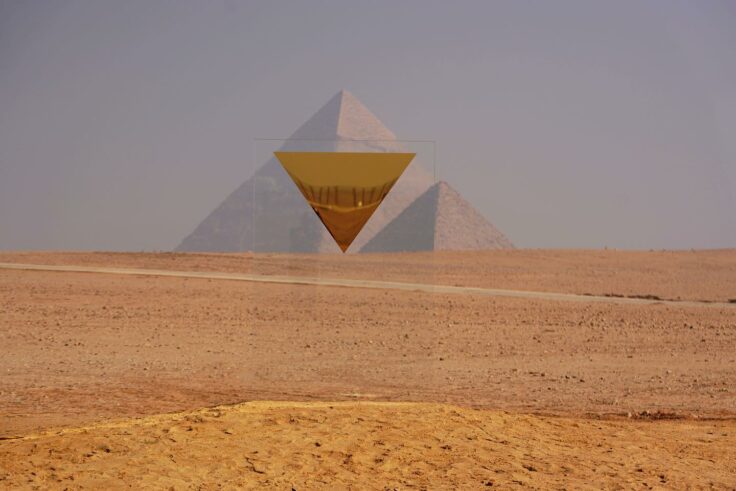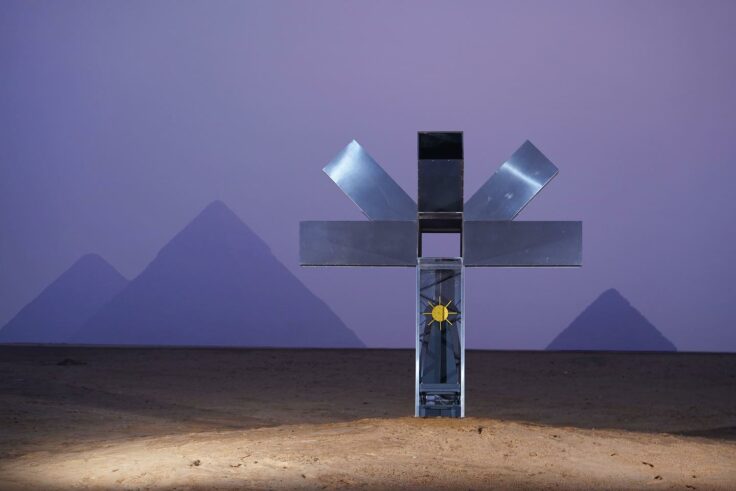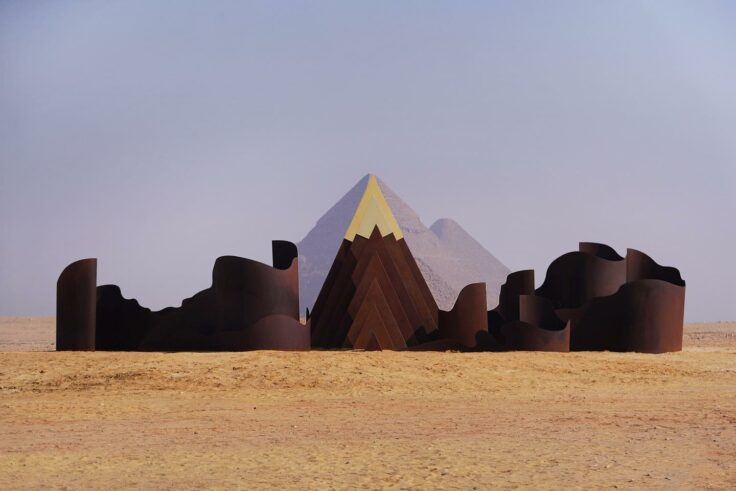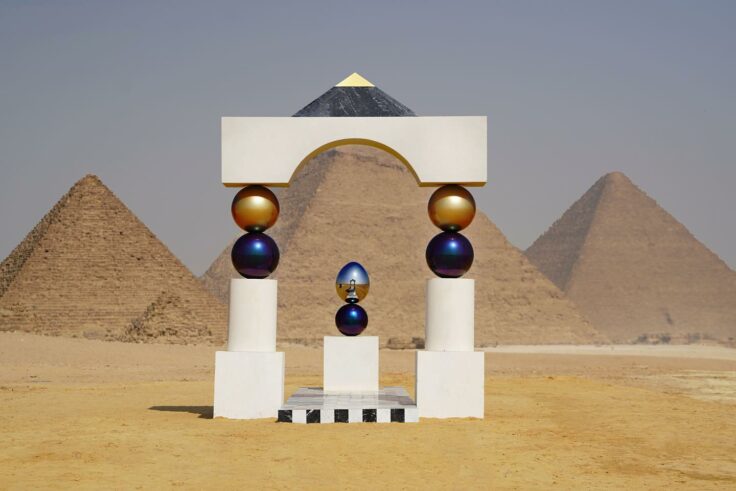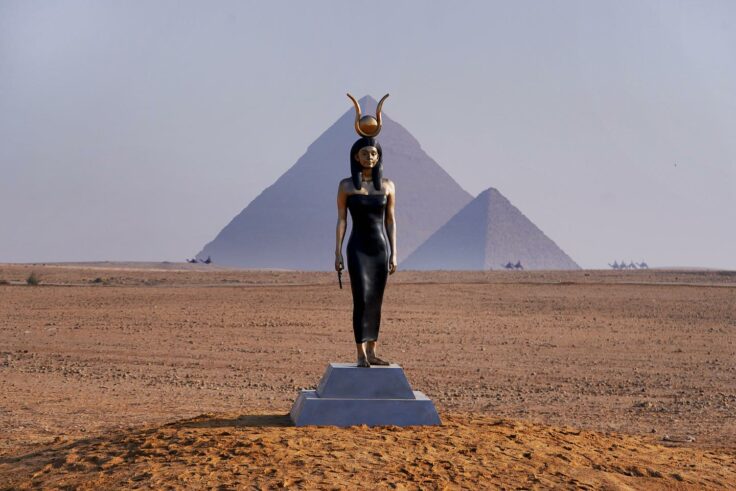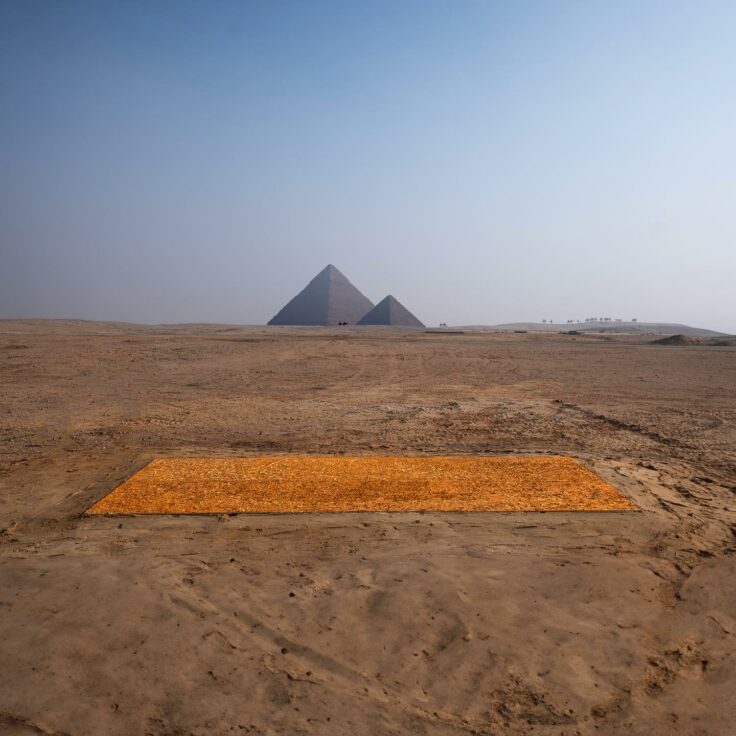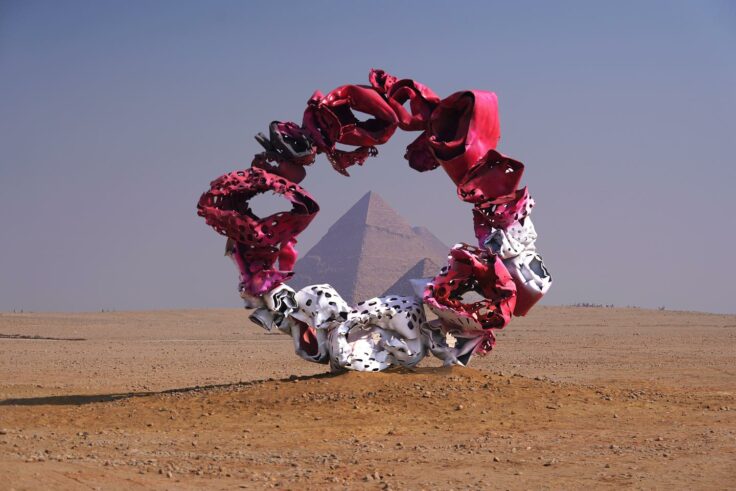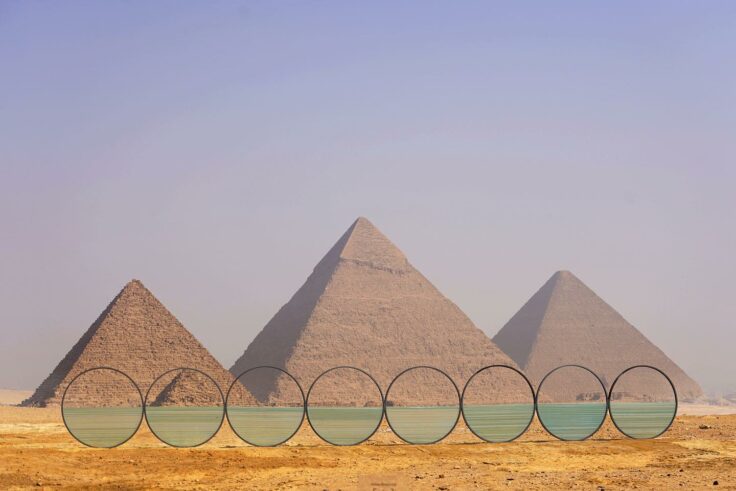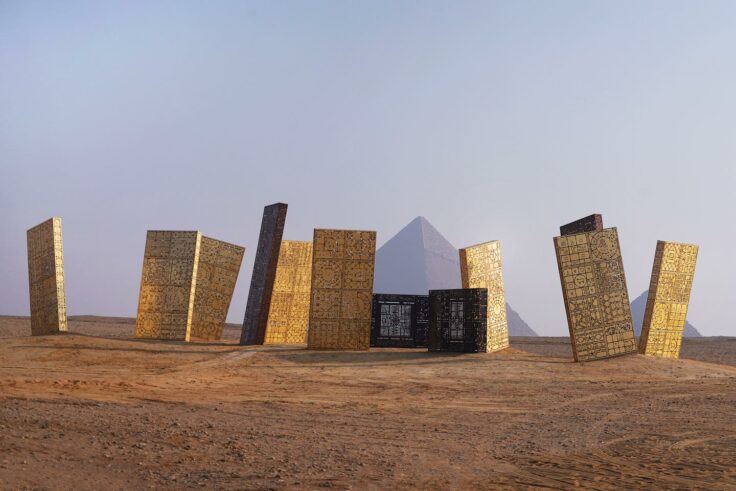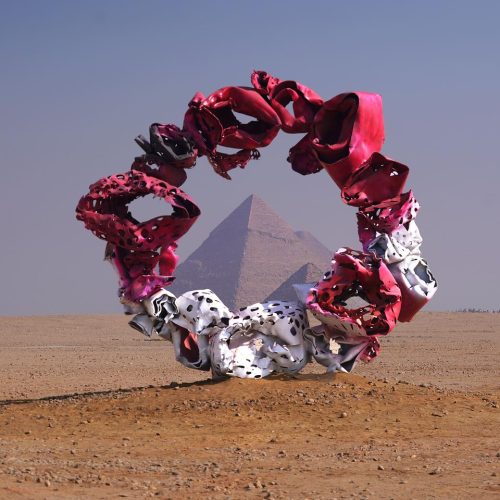The third edition of Art D’Egypte’s annual “Forever Is Now” art exhibition kicked off on Oct. 26 with 14 impressive, large-scale contemporary art installations against the backdrop of the Pyramids of Giza from renowned artists hailing from Saudi Arabia, The Netherlands, Brazil, and beyond. All centered around the concept of “play,” these captivating works invite the viewer not to merely observe but to immerse themselves in a dialogue between the artist, and the profound historical backdrop, where inner reflections can be made. Below, discover the 14 jaw-dropping installations that make up the 2023 Art D’Egypte.
Translucent Pyramid by Rashed Al Shashai
Saudi Arabia
By reinterpreting the pyramids in a contemporary way, Translucent Pyramid pays homage to their history, while offering a contemporary interpretation of their impact on our region’s development. The installation emphasizes the value of preserving traditional methods while embracing innovation and creativity. Through a dance between the past and present, this site-specific installation blurs the lines between tradition and modernity, redefining our perceptions of art, heritage, science, and sustainability.
RA by Sabine Marcelis
The Netherlands
By using laminated solar glass, this functional sculpture embodies a symphony of elements. After dusk, it harnesses the sun’s energy to illuminate its gnomon (the part of a sundial that casts a shadow.) As the day progresses, the artwork creates an ever-changing footprint of light.
The Ghost Temple by Sam Shendi
Egypt & UK
The Ghost Temple aims to illustrate the imprint Ancient Egyptian civilisation left on the land that shows imagination can transcend time.The artwork highlights how one can imagine structures that are no longer there, and feel the energy and the spirit that radiate into the atmosphere.
Inside Out Giza 2022/2023 by JR
France
Inside Out Giza 2022/2023 was brought to life through the Inside Out Photo Booth installation in Egypt during Forever Is Now 2022, with more than 3,600 participants visiting the pyramid-shaped interactive photo booth. Each participant received a large-scale black and white portrait that they got to paste onto a billboard and temporarily see together with the Great Pyramids of Giza. The pictures will be displayed collectively in conversation with the UNESCO world heritage site this year, making a bigger statement than ever before.
As Above, So Below (Dome of Starry Sky) by Mohamed Banawy
Egypt
As Above, So Below’ (Dome of Starry Sky) is inspired by Egyptian cosmic laws that juxtapose the material and spiritual worlds, and the Egyptian Goddess Maat’s confessions that embody laws of balance and harmony.
TEMPLE by Stephan Breuer
France
A golden triangle that appears to float in space, conveying a powerful and immaterial vision of pure light, TEMPLE acts as a sign within the landscape to stop and take a moment to contemplate both the exterior world and the one within us in gratitude.
Observatory Meta Oiko by Artur Lescher
Brazil
By using the interior of the pyramids as a reference, Observatory inverts the scales to depict the magnificent panorama of the pyramids from a new perspective and also to consider the human scale from a new perspective.
Treasures by Azza Al Qubaisi
UAE
With this piece, a journey is effortlessly captured through the shapes, patterns, textures, and memories of the desert landscape, colliding with the cultural memories, stories, and motifs of the past. Through earthy colors, the work reflects the surrounding nature. The installation resembles a maze allowing viewers to become immersed in the experience of walking between the artwork and the lines of the sand dunes to reach the pyramid while seeing their reflection like an inner journey.
Mirror Gate by Pilar Zeta
Argentina
Mirror Gate is inspired by ancient mysticism of Egypt using the material of limestone. The checkerboard pathway, an allegory of duality, leads to a mirror egg, symbolizing the potential for all things and the exploration of one’s subconscious that create a contrast between temporal realms.
Egyptian Woman in the Form of the Goddess Hathor by Carole A. Feuerman
USA
As Feuerman’s interpretation of Hathor, the Egyptian Woman in the Form of the Goddess Hathor depicts the deity as a contemporary woman who embodies her essence. Hathor holds an immense significance in Egyptian mythology and Feuerman aims to convey the graceful fluidity, as the ancient goddess is often associated with water and fertility.
Meditation on Light by Dionysios
Greece
Meditation on Light represents Apollo, god of light, conversing with Ra’a, god of the sun. The installation uses AI to create different invocations on the theme of light. Once on the gold carpet, the viewer becomes a participant, immersed in the landscape and challenged to make sense of what seems bare.
Lupine Aurora by Arne Quinze
Belgium
The Lupine Aurora sculpture explores the dynamics between strength and fragility in nature. This piece of art is inspired by ancient and rich Egyptian culture, where the sun always played an important role. Through a circular sculpted outline, the sun, seen as the source of all life, is addressed in this work. The circle represents the recurring cycle of day to night within our solar system, as well as the relationship between the planets and the sun.
Horizon by Costas Varotsos
Greece
Horizon emphasizes the relationship between the Nile River and the Giza Pyramids Plateau, underlining the projection that the ancient pyramids give to the world. This new horizon is defined by eight circles in which the world revolves. Τhe celestial dome and the cycle of life, expressed through the geometry of the circle, are concepts identified with the geometry and history of the pyramids. The materiality of the artwork is a connection of all the natural elements of the surrounding area. The concept of the horizon defines space but at the same time defines an attitude towards life.
Reality is Timeless by Rashid Al Khalifa
Bahrain
Reality is Timeless plays on the concept of time and discovery influenced by ancient mythology. Rashid Al Khalifa creates relics tilted at varying angles that emerge from the ground, representing fragments of a labyrinth. The fragments all feature different motifs derived from the 17th-century Jesuit scholar Anthanasius Kircher’s Turris Babel (1679) diagram of the Egyptian labyrinth. The perforated motifs on the copper and brass exterior oxidize beautifully and cast shadows of light.





